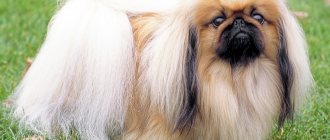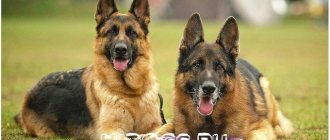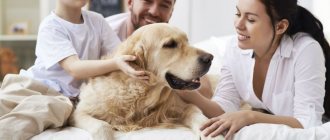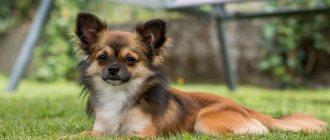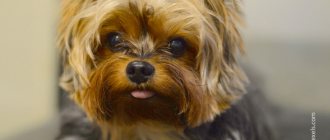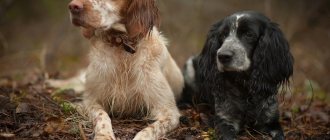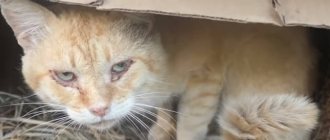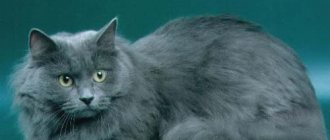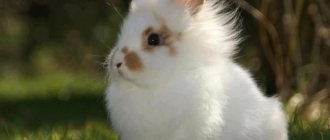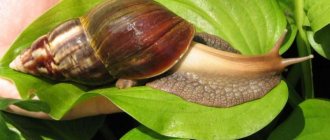Story
In appearance, huskies are similar to wolves. This similarity is not accidental and they are truly related. Presumably the origin of the genus occurred four thousand years ago. The northern peoples, living in remote corners of the country, developed along their own course. Some often wandered, others led a sedentary lifestyle, but all needed reliable four-legged helpers.
For obvious reasons, no one was engaged in breeding horses in a region far away and dank from blizzards and frosts, and this activity would have turned out to be pointless. And it was important to move yourself and transport your property from place to place. And strange as it may seem, wolves came to the aid of people.
Many northern breeds are descended from wolves. Previously, no one looked for differences in pets; they were divided only by their character, or rather by their desire to serve a person. There were semi-wild dogs that no longer formed packs, like their ancestors howling at the moon, but also did not fawn over humans like modern pets. Selection took place gradually and according to principles completely incomprehensible today.
Understanding the development and origin of northern dogs is further complicated by the fact that no records of the domestication of wild animals have been preserved, because they never existed. Residents of the north are not very accustomed to writing, and especially to recording all their scientific or creative research on paper.
But we still know that, depending on the habitat of the Husky tribe, they were divided into two types . The first lived on the plain and participated in farm work, such as herding livestock, transporting goods, and guarding the house. Others set up their villages along the seashore and went hunting and fishing with their pets.
The Chukchi War of Independence only strengthened people's attachment to their faithful four-legged friends. Dogs helped transport cargo, participate in reconnaissance, obtain meager food and fight. Achieving the goal in the eighteenth century did not bring relief from strong pressure from the rulers of Russia, and the independence of the quadruple peoples turned out to be formal.
The iron will of the USSR almost destroyed the huskies, considering these animals unsuitable for the needs of the great country. Breeding of the breed was stopped, selection experiments too, the destruction seemed to have reached its final result, then the unexpected happened. Gold was found in Alaska, and humanity remembered those who could help the team move through the snow, transport people and large mountains (the dream of every applicant) of gold.
The need for huskies increased to such an extent that everyone rushed to look for surviving individuals. Those who were able to breed the breed immediately began this activity, looking for their golden mountains in it (and succeeded more than many applicants).
Aboriginal breeds fell into the hands of both truly experienced and knowledgeable breeding specialists, as well as those who simply wanted to make money from the current situation. Unfortunately, such indiscriminate reproduction led to the loss of purebred, but contributed to the consolidation and division into species.
Do not confuse Alaskan and Siberian huskies - they are completely different species. America was in love with gray and inconspicuous animals, capable of learning, hardy and loyal. It was there that the first officially registered standards appeared, and this happened in 1934.
While the appearance of the hard worker seemed inconspicuous, no one even dared to think about participating in exhibitions, but one day a miracle happened and a baby was born with blue eyes and a beautiful body color, on which a dark “saddle” stood out. From this period, a race began to breed the most beautiful pet, taking first place at exhibitions.
This was a time of recognition not only of the working qualities, but also of the beauty of northern Aboriginal breeds. The work that breeders and scientists did, improving and polishing the “Siberian diamond” donated to modern society by wild tribes, is simply invaluable. Thanks to the excellent result, today we find four-legged friends who protect our home, accompany us on our travels and share ordinary everyday life with us.
Maintenance in a country house, private sector
Sometimes people living in the private sector or outside the city try to place a husky in a house, believing that the pet will be warmer and more comfortable there. This is fundamentally wrong. The frost-resistant husky feels great in winter. Even if the husky’s kennel is comfortable and well-equipped, the dog often prefers to sleep in the snow.
There is no need to try to build a house with insulation. The priority is to purchase or build a well-ventilated, non-insulated booth that is comfortable and cozy. The recommended dimensions of a husky booth are as follows: height - 90 -120 cm, length 1 - 2 m. It is advisable to provide a heated floor in the puppy house, which should be removed later when the animal grows up.
It is imperative to build an enclosure for a husky using a steel mesh with rods at least 0.5 mm thick. Chain-link is not suitable, since husky enclosures made of this material are very fragile. As a floor covering, you can choose rough paving slabs. It is permissible to have an earthen floor with reinforced contours and fencing bases, since a curious dog is quite capable of digging a tunnel and breaking free.
The optimal size of an enclosure for a husky directly depends on the dog’s height. An animal with a height at the withers of less than 50 cm needs an enclosure with a minimum area of 6 sq.m. A larger pet, whose height is between 50 and 65 cm, should be provided with an enclosure of 8 sq.m. A four-legged friend whose height exceeds 65 cm will feel good in an enclosure with an area of 10 sq.m. or more.
In the summer, it is worth taking care of the presence of a canopy over the enclosure from rain and sunlight. It would be a good idea to surround the area adjacent to the house with a high fence so that the dog cannot break through its perimeter.
There is no need to hope that the husky will become a ferocious guard of private property. This breed has a completely different purpose.
Breed characteristics
These days, huskies are still marketed as sled dogs. They are distinguished by strong bones, a proportionately developed body, strong limbs and enviable endurance. They have an interesting voice, they do not bark like ordinary dogs, but wheeze a little and this wheezing can be heard only in rare cases. More often they are silent.
The appearance of our heroes can be described by the following parameters:
- The head is proportional to the body. The wide forehead gradually tapers towards the base of the nose. The bridge of the nose is smooth and straight, neatly rounded at the tip. When viewed from above, the head is shaped like a triangle. The teeth are straight and in the correct bite. The lips are thin, outlined in black.
- The nose is elongated, but looks sophisticated and attractive. Pigmentation directly depends on coat color. Black, brown and pink variations are allowed.
- The eyes are oval-shaped, slightly slanted. They are located on both sides of the nose not at a great distance from it. The iris can be blue or brown, of any saturation level. There are also monochrome eyes.
- The ears are shaped like a triangle, rounded at the ends. They are medium in size and stand upright.
- The body has the shape of a rectangle. An interesting feature is the lean but powerful body. The muscles are developed quite strongly. But with its impressive weight, the dog looks elegant and graceful due to the narrow structure of the chest.
- The limbs are strong, smooth, and widely spaced.
- The tail is strong, strong, mobile, quite long and completely covered with hair. A tail curled into a ring or lying on the back is considered a disadvantage.
- The guard coat fits quite tightly to the body, as if outlining a silhouette. The undercoat is very dense, hard, protecting the animal from cold and heat. During the molting period, it can fall out completely and then grow back.
- Colors have no restrictions, as do types of patterns or markings. The most common color is wolf.
Life expectancy for boys and girls
On average, the life expectancy of Husky is 12-15 years.
However, how long a pet will live depends to a large extent on the conditions of its keeping, diet, physical activity and many other reasons. Only if all these conditions are met will the husky live to these years.
If the pet is poorly cared for, not given enough walks, does not take care of its health, and at the same time is fed anything, then the dog will hardly be able to live up to 10 years.
Speaking about who lives longer - boys or girls, it should be noted that males of this breed have a predisposition to diseases of the genitourinary system, which can significantly shorten their life.
It is also believed that older Husky males are more likely than females to develop hypertension, which can also affect their life expectancy.
However, Husky girls, due to improper breeding or under the influence of certain drugs that affect reproductive function, can also develop diseases of the genitourinary system, for example, pyometra, which often leads to very serious complications and even death.
If the owner of a husky does not intend to get offspring from his dog and at the same time wants to prolong its life, he can resort to sterilization or castration.
Nutrition and education
Huskies are pets with character. If you are able to satisfy all his needs, then he will be grateful to you for this and will not cause any trouble. But just try once not to walk the animal and give it free rein to frolic, you will regret it.
As for training, everything will not go smoothly here, especially if you are new to this matter. It’s better to trust a professional and just follow the work, because patience, perseverance and the ability to suppress the natural instincts of those under your care are necessary in this matter.
Huskies need socialization and the most acceptable option would be joint walks with other owners of northern dogs. From their distant ancestors, they inherited a gregarious nature and they feel calm and confident when surrounded by their own kind. If you don’t have this opportunity, then try to go for a walk in the park or in places where there are crowds of similar dog breeders walking with their pets. Huskies are very friendly animals and will be happy to have any communication.
These are very smart dogs for whom the learning process is not just important, but necessary. You should never raise your voice at your ward if he refuses to obey. Only patience can be your weapon in the battle for husky obedience.
Group classes are best. Not only do dogs feel confident in the company of others like them, but their natural tendency to imitate produces positive results. They will repeat one after another and master the commands faster.
Caring for a pet is quite simple. Brush the coat two or three times a week. You should only bathe your dog for a very important reason. Check your ears, eyes and nose daily. Clean with a slightly moistened cotton swab. The condition of the claws also needs to be monitored.
As for teeth, standard measures will suffice. Buy special bones for cleaning enamel. If you notice plaque, it is best to remove it in specialized veterinary clinics.
You can choose either natural or specialized industrial food for your Husky. Many well-known companies that have established themselves in the market and have gained the trust of well-known breeders produce food specially designed for the breed. When choosing a brand, beware of an allergic reaction, so don’t immediately stock up on a huge bag.
If you are a fan of natural nutrition, then you will have to take the time to select quality ingredients from the market and prepare food. The following products are permitted :
- Meat is the basis of the diet, and it must be of high quality. Raw meat is pre-frozen for several days in the freezer, and only then can it be given to the pet, having previously been defrosted to room temperature. This way you can be sure that there are no parasites.
- Be sure to offer your pet sea fish several times a week. It contains the B vitamins your dog needs.
- Chicken or quail eggs.
- Offal.
- Cartilage.
- Dairy products. Watch out for fat content. It is not necessary to buy low-fat cottage cheese or sour cream, but it is better to stick to the average options.
- Vegetables.
- Porridge. Only three types of cereals are suitable: oatmeal, buckwheat and rice.
Consult your veterinarian about vitamin supplements. It is possible that there is a need for them only during certain periods of the year.
How to make your Siberian Husky live longer
In order for a husky to live as long as possible, the owner must follow the basic rules of care:
- The Siberian people are very active. The animal cannot sit still and does not tolerate confined spaces. Therefore, for its full development, it is very important to provide physical activity. You need to try to walk the dog more often and give him the opportunity to run. Veterinarians recommend engaging in sports disciplines and training with your dog;
- It is important to properly monitor your pet's health. Be sure to do all the necessary vaccinations according to the schedule and carry out treatment against parasites. If your dog is sick, you should take it to the vet immediately. After seven years of age, Huskies should undergo annual preventive examinations.
Special care should be provided to older dogs. The pet needs to be regularly taken for examination, provided with physical activity and proper nutrition.
Important! You can tell if your pet is sick by the condition of his eyes. As soon as they become cloudy or their shade changes, this indicates the beginning of the inflammatory process.
Regular examinations by a veterinarian play a big role in your health.
How many years do they live
The average age of northern friends is from twelve to fifteen years. Naturally, not only life expectancy is important, but also its quality. Huskies are naturally in excellent health, but require periodic preventive examinations.
Like other species, they have a predisposition to certain ailments, and it is better to identify them in the early stages. The main problems that may arise are:
- ophthalmological nature,
- with the cardiovascular system,
- skin diseases,
- diseases of the testicles and males,
- related to neurology.
Maintenance and care
The breed was first bred in northeastern Siberia. In the early 30s of the 20th century, dog handlers already included it in the register as a sled dog.
The Husky's wool and thick undercoat save it from severe cold, and the pet also has increased physical activity. Therefore, it requires strength training and running.
Take the Attention Test! Find 10 differences! (click right here!)
Find the answer Are you bothered by some problem or question? Enter “Breed” or “Name of the problem” into the form, press Enter and you will find out everything about the issue that interests you.
Impact on lifespan
Blue-eyed pets are often kept in apartments.
What does a pet need:
- A varied diet and diet.
- Big flat.
- Walks and activity.
- Love and care.
Protect your dog from stress. Don't yell at the dog.
If you are planning to buy a puppy, then find out about the nuances of their content, behavior and character.
Contents in the room
The dog requires constant training. She should play and run daily, at least 2-3 hours a day.
Do not make a guard dog out of a dog; this breed is not suitable for this.
Balanced diet
The diet should include:
- Liver;
- Meat;
- Cereals;
- Vegetables.
- Egg yolk;
- Fish;
The dog will not eat the same food and will lose all interest in food. Don't give your dog chicken or chicken. Potatoes, salty and smoked foods should not be given.
Cook fish before feeding. Meat can also be given raw, but its share should not be more than 25% of the total weight of the feed. Do not give chicken bones - replace them with large pork or beef ones. Add vitamins to the diet if you do not feed your dog food.
Male or female
Complications from serious illnesses lead to death.
Males suffer from diseases associated with the genitourinary system and hypertension.
Bitches often have pyometra.
You can spay/neuter your dog if you do not intend to breed puppies. This way you will protect your pet from possible early death.
Reviews
A few reviews:
- “To everyone who is not yet familiar with this fluffy happiness, I can only wish you to improve your life for the better as soon as possible. You not only gain a friend, but also a remedy for depression and melancholy.”
- “Be careful with your dreams, they tend to come true. Keeping a husky in an apartment is very tiring: a lot of cleaning, dirty furniture, torn things. And during a walk, your pet may run away, break from the leash, or pull you in a different direction if it suddenly wants to go there.”
What determines the life expectancy of a husky?
Huskies are wonderful companions with many important advantages. They are not only friendly, calm, independent and easy to train, but also resilient and strong. These characteristics have a particularly noticeable effect on how long Siberian Huskies live: their endurance ensures their mobility even in adulthood, and their incredible strength contributes to their love of activities, which only prolong their life. In addition, huskies in general are not prone to hereditary diseases, which cannot be said about most other breeds. In adulthood (10-12 years), disturbances in their body rarely occur, and owners usually do not have to worry about their well-being.
Character of the Alaskan Husky
Temperament
With different mixes, the possible temperament can vary as much as appearance, but in general they are hardworking, affectionate, loyal and determined.
They are pack oriented, so they need a lot of interaction from either other dogs or their human family. He needs experienced owners, this is generally not a breed for a novice owner.
He also needs you to be home more often and needs very active owners if not kept at work or sledding. He will not be happy if he is left alone for a long time.
Alaskan Huskies tend to be very focused and disciplined, but they love to run! He gets along well with people and loves attention.
He also has a playful side and has a very cheerful and happy personality. He loves his family, loves a good cuddle and gets along well with strangers, being so easy to talk to. Because of this, although it is not a very good watchdog, since it wants to make friends with everyone.
Norms and feeding regime for a puppy and an adult husky
First, they decide on the type of feeding: buy industrial feed or cook it yourself. Different enzymes are responsible for digesting dry kibble and natural foods. With a mixed diet, digestion does not have time to rebuild, food is poorly absorbed, and fermentation begins in the intestines.
The daily amount of dry food is written on the packaging. With natural feeding, you will have to calculate it yourself. The volume of food is determined by body weight:
These are average norms; the specific amount of food depends on the animal’s mobility and physical activity. If the ribs cannot be felt, it means the pet is overfed; if they stick out too much, there is not enough food.
Up to 2 months, the puppy is fed 5-6 times a day; as he grows up, the portions increase and the number of feedings decreases:
| Age, months | Number of feedings |
| up to 2 | 5 – 6 |
| 2 – 3 | 4 – 5 |
| 3 – 6 | 4 |
| 6 – 8 | 3 |
| 9 and older | 2 |
Adult dogs are fed twice a day, preferably by the hour: in the morning no earlier than 8-00, in the evening no later than 22-00. The bowl of food is left for 20 minutes, then removed until the next feeding.
Who is the breed not suitable for?
- These pets are characterized by increased activity. They need to train a lot, walk, play. Therefore, Husky is not suitable for homebodies, sedentary people and elderly people.
- In addition, dogs are strong and fast. In case of escape, an unhealthy person will not be able to catch up with an animal that has not been trained in commands.
- Also, puppies need to be trained for a long time and persistently, accustoming them to the rules of behavior, walking and feeding regime. If the family is not prepared for the fact that at first the dog will not be obedient, neat and restrained, then getting a Husky is not recommended.
Even a teenager can work with representatives of the breed, because they learn quickly and easily. But the dog is best suited to an avid dog breeder who has already kept northern Laikas or similar pets. Although a beginner can practice his training skills with these doggies.
